The post 10 Hiking Trails Around the World That Will Blow Your Mind appeared first on The Expeditioner Travel Site.
]]>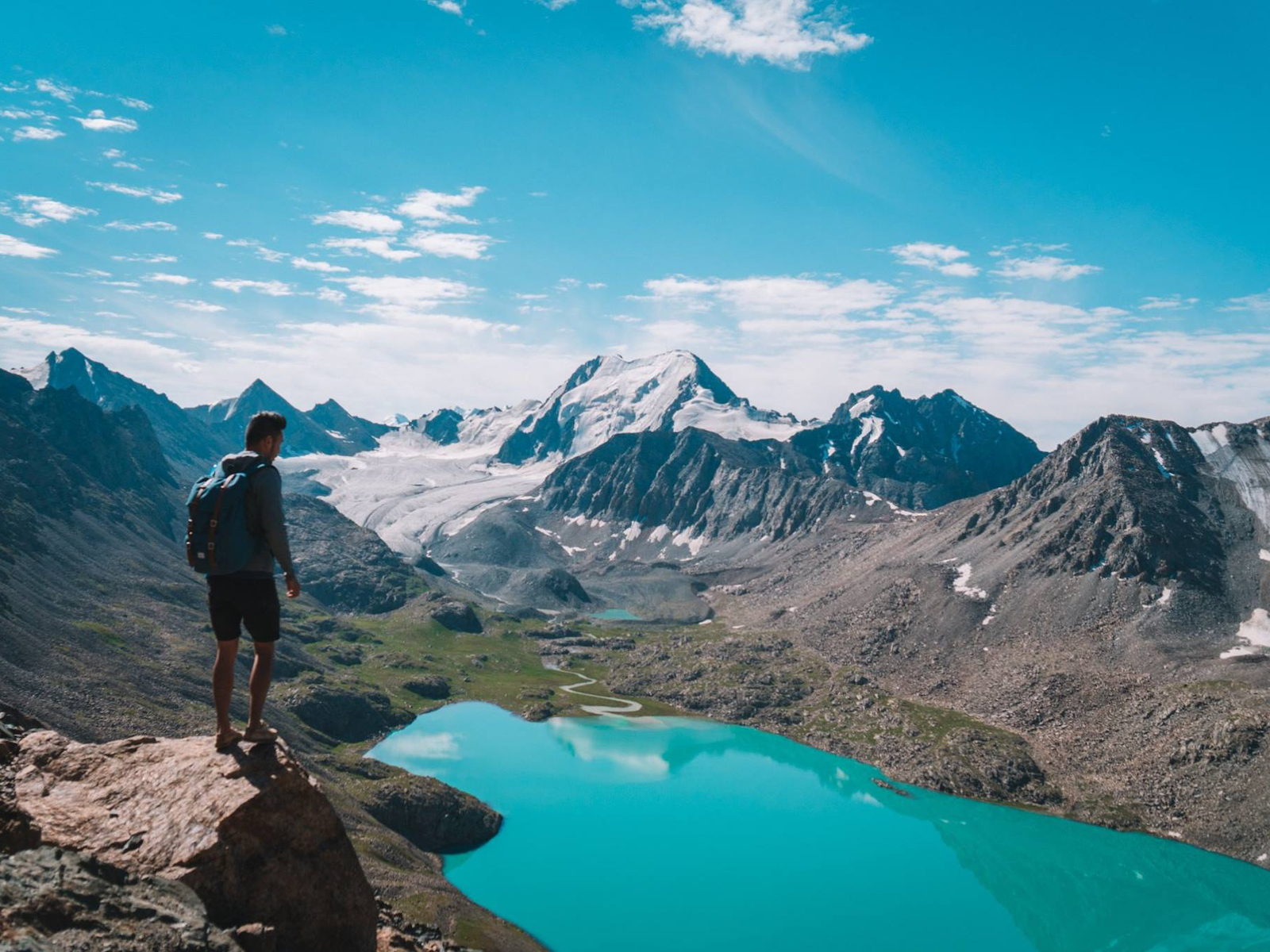
I have always been a nature person. Cities, for me, seem unnecessarily chaotic and at times, overwhelming. Nature, on the other hand, is simple, straightforward in its beauty and comes at no extra cost. There is nothing better than walking in the peacefulness of the mountains, around the calming sound of rocks and rivers, and having the front seat row to Mother Nature. Whenever I have a chance to disconnect from the world and go on a four-day trek in the mountain, I would do so with no hesitation.
I first discovered my love for hiking in 2014 in Nepal, when I decided to go hike the Annapurna Base Camp trail alone with no porter or guide. It was a huge endeavor for me since I never had any previous hiking experience and I never thought of myself as “outdoorsy”. Everything changed after that and now, I tremble with excitement every time I see a trail I could hike into the heart of the mountains.
After 6 years of traveling around the world from Peru to New Zealand, I have compiled a list of my top 10 hiking experience from around the world. The trails lengths range from 6 hours to 7 days, 1,000 meters to 4,700 meters high, and from a stroll to me dragging my feet to the top. Without further ado, let’s begin with my first trek ever.
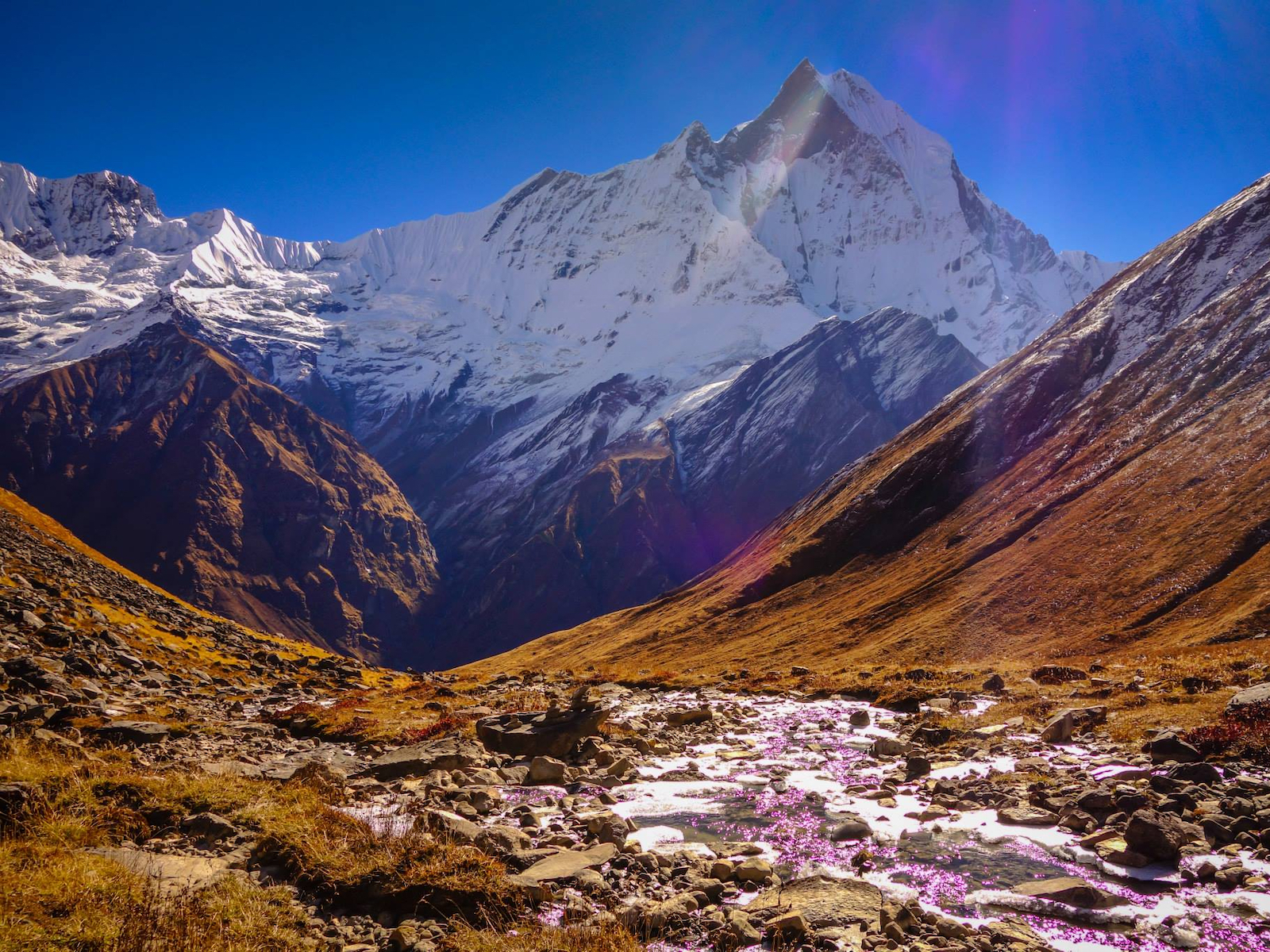
1) Annapurna Base Camp Trek (Nepal)
Location: Pokhara, Nepal
Length: 7 – 10 days return
Highest Altitude: 14,107 feet
Distance: ~75 miles
Difficulty: Moderate
This was my first hike ever and it is still my favorite and most memorable out of all. The trail begins in the beautiful city by the lake with a view of the Himalayas, Pokhara. The trail is considered to be one of the most diverse in Nepal, even more so than the Everest Base Camp trail. You start walking through a lush green forest, going up and down valleys, crossing several massive suspension bridges and through the bamboo forest. Pace yourself past the avalanche-prone valley and eventually you will be surrounded by several 26,000-foot-high peaks of the Himalayas.
Nothing will make you feel accomplished and humbled at the same time as conquering the Annapurna Base Camp trail and still being towered by not one but several higher ones. It’s even more intimidating to know that one of the mountains surrounding you at the base camp, the Annapurna, is one of the least climbed and the deadliest out of all the 26,000-foot peaks with the highest fatality rate at 40.8%. That feeling of accomplishment will be with you for several months to come after.

2) Ala Kul Trek (Kyrgyzstan)
Location: Karakol, Kyrgyzstan
Length: 2 – 4 days return
Highest Altitude: 11,600 feet
Distance: ~33 miles
Difficulty: Moderate
For such a small off-the-beaten-path country, Kyrgyzstan has a lot to offer for nature lovers with stunning canyons, pristine alpine lakes and plenty of hiking trails, all tucked away in the unexplored mountain range of Central Asia. One of that trail is the Ala Kul trail, a two to four-day hike that starts from the city of Karakol. This route will take you through one of the most stunning forests rich with vegetation and wildlife, then you get to camp under the stars at Ala Kul Lake. The best way to end this three-day hiking trip is to make your way down to Altyn Arashan, where you can soak in a nice natural hot spring.
The highlight of this trek though, is the Ala Kul Lake. You will have to hike along the side of a mountain passing the lake to the 11,600-foot-high pass and from there, you will be rewarded with a panoramic view of this alpine lake and the mountains behind it.

3) Grand Balcon Sud and Lac Blanc Trails (France)
Location: Chamonix, France
Length: 8 – 10 hours return
Highest Altitude: 7,716 feet
Distance: ~9.3 miles
Difficulty: Moderate but Long
The French Alps offer hikers plenty of opportunities to get lost in nature for a few hours with several trails for both single and multi-day hikers. One of my favorite single-day hikes is a combination of the Grand Balcon Sud trail and the Lac Blanc trail. The Grand Balcon Sud trail will take you up and along the side of the mountain overlooking the city of Chamonix and Mont Blanc. Throughout the trail, you will be rewarded with the beautiful jagged peaks on your right and colorful vegetation and wildlife on your left. If you are lucky, you might be able to witness the Chamois like I did when I was hiking up the Grand Balcon Sud trail in the early morning.
Towards the end of the Grand Balcon Sud trail, you can continue on the Lac Blanc trail to see the White Lake where the magic of this trail is. If the weather is calm enough when you arrive at the lake, you will be rewarded with a perfect reflection of the French Alps on the lake. It was quite a sight to behold.
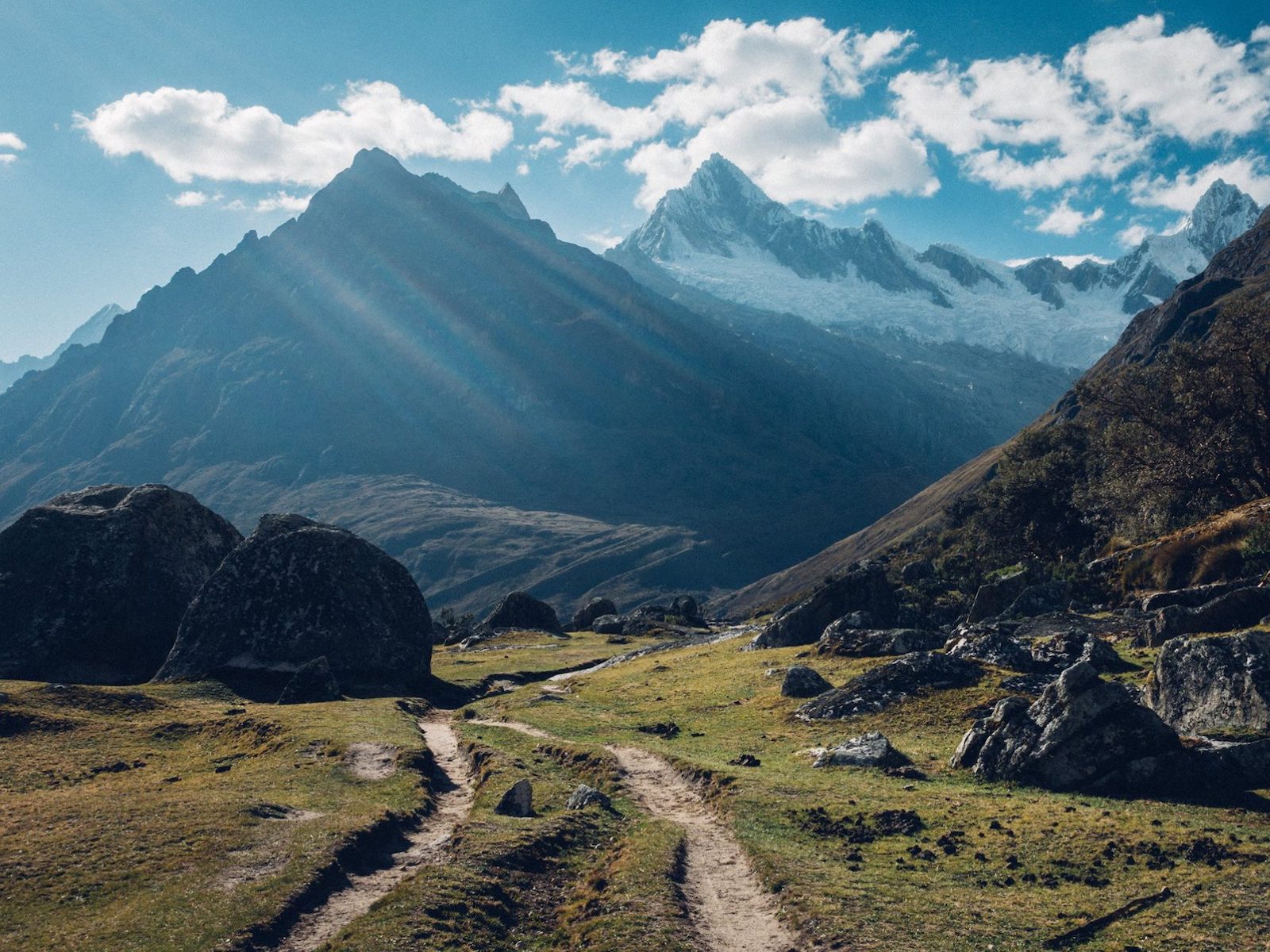
4) Santa Cruz Trek (Peru)
Location: Huaraz, Peru
Length: 3 – 4 days return
Highest Altitude: 15,583 feet
Distance: ~22.3 miles
Difficulty: Moderate
Huaraz in the north of Peru is one of my favorite places on Earth. I spent almost twoeeks alone in this city, exploring some of the best trails in the Cordillera Blanca mountain range. When people come to Peru, they always head for the south for the Inca trail and call it a day. What they don’t realize is that the true beauty of Peruvian mountains lies in the North, in Huaraz.
One of the treks I did was the Santa Cruz trek. I spent four days hiking in the solitude of the Cordillera Blanca mountain range through a beautiful canyon, stunning valleys and a pristine blue lake that serves as a great spot for camping. You will pass through one of the most beautiful scenery you will ever see in your life, sleep under the shadow of the towering Taulliraju mountain and be rewarded with a panoramic view of the mountain at its highest point of Punta Union Pass.
The experience of hiking this trail alone, carrying all my gear and food for four days, made it even more challenging and left me in awe for the rest of my trip in South America.
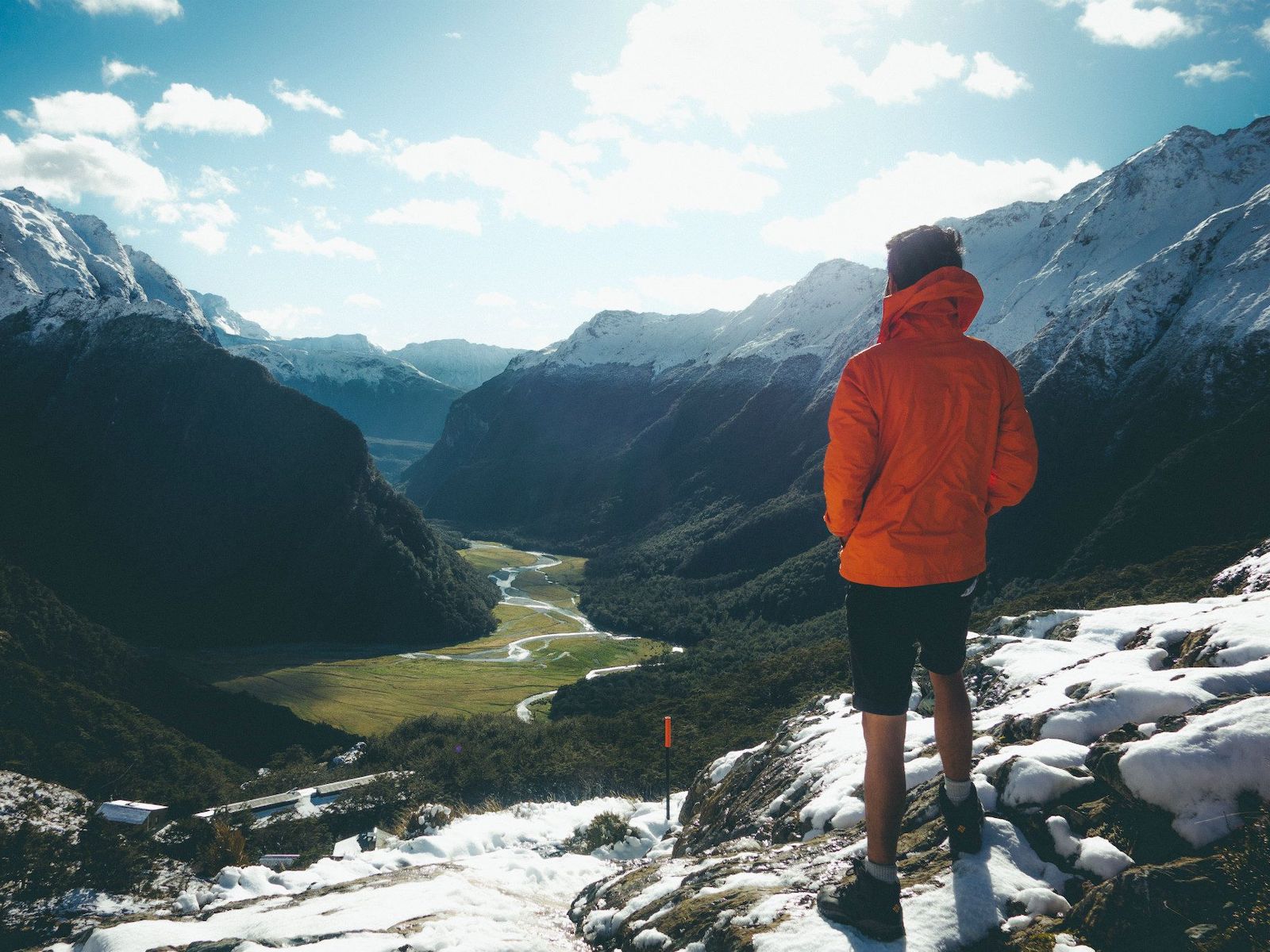
5) Routeburn Track (New Zealand)
Location: Te Anau, New Zealand
Length: 3 – 4 days return
Highest Altitude: 4,117 feet
Distance: ~20 miles
Difficulty: Easy
The Routeburn Track is one of New Zealand’s best great walks and for good reasons. The trail is located in the beautiful South Island starting near Te Anau and ends near Queenstown.
The trail will take you to the Key Summit on your first day, back down to sleep by the MacKenzie Lake, passing through the valley along the exposed Hollyford Face with expansive views over the Darran Mountains. Then it’s up to the Harris Saddle Shelter before coming down to Routeburn Falls Hut for your last night.
Your last day will be a casual walk down through the stunning beech forest, with a view of the Humboldt Mountains and ending at Routeburn Flats Hut. The Routeburn Track sure is an action-packed trail for you to do in New Zealand.
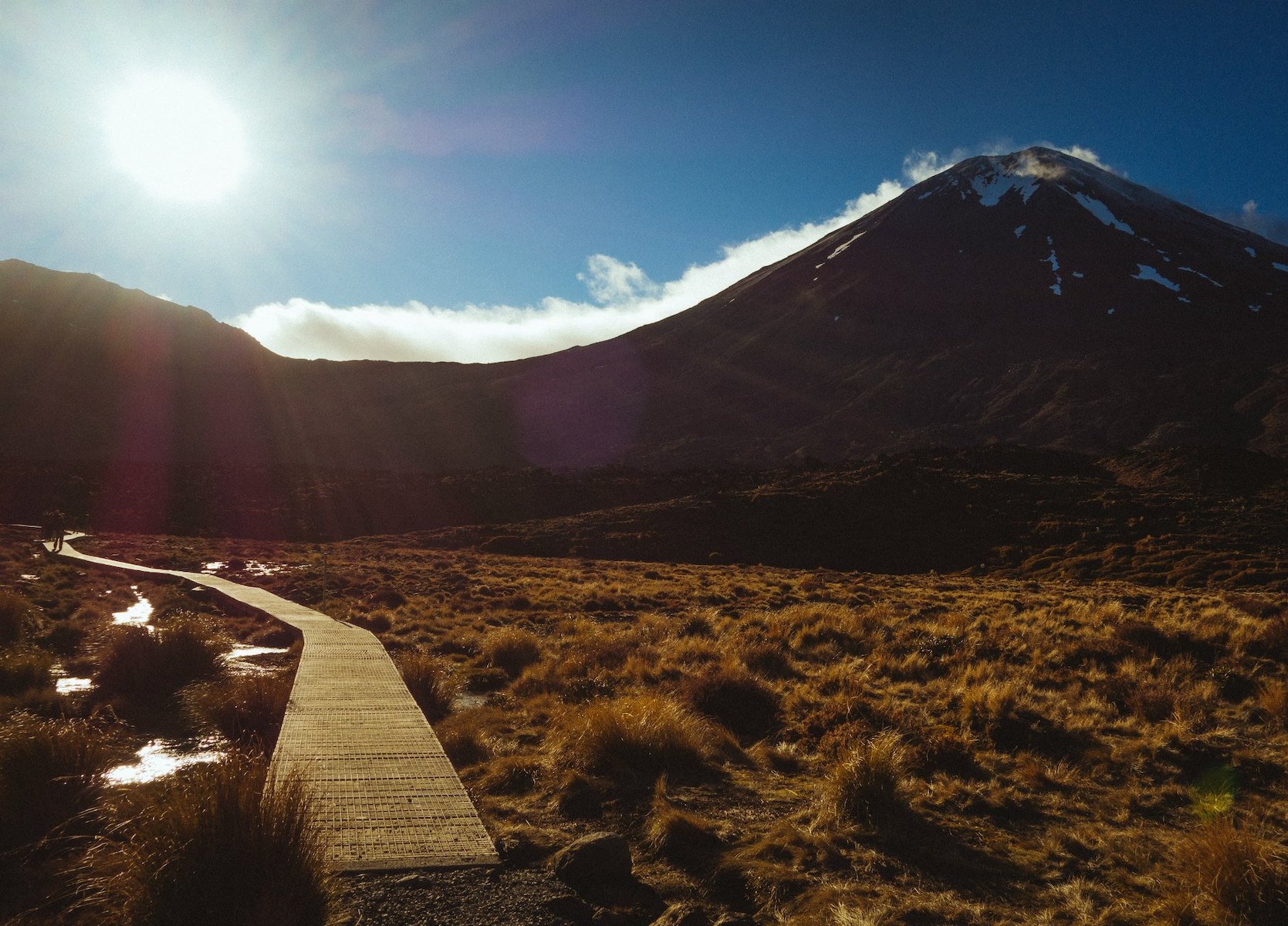
6) Tongariro Crossing (New Zealand)
Location: Lake Taupo, New Zealand
Length: 5 – 7 hrs return
Highest Altitude: 3,674 feet – 7,516 feet
Distance: ~ 12 miles
Difficulty: Easy to Moderate
Another great trail in New Zealand is the Tongariro Crossing trail, located in the North Island of the country near Lake Taupo. Like most trails in New Zealand, the Tongariro Crossing trail has a well-paced climb with casual walk up and steep parts all scattered throughout equally.
Starting from the Mangatepopo Valley, you will go through a series of gradual and steep climbs until you reach the saddle between Mount Tongariro and Mount Ngauruhoe. From here you can take a side trip like I did to go up Mount Ngauruhoe or to Mount Doom for Lord of the Rings fan. The trip will take two extra hours to do so but you will get a stunning view of the crossing in one whole swoop.
From the saddle, you will have to go through the South Crater before climbing again to the Red Crater. You will be able to see two lakes from up there, one in emerald green and the other in pristine blue. When you pass all the lakes, you will then have to zigzag your way past Ketetahi Shelter and down to the end of the trails.
The scenery is so diverse, it will have you thinking you were trekking for several days instead of five to seven hours.
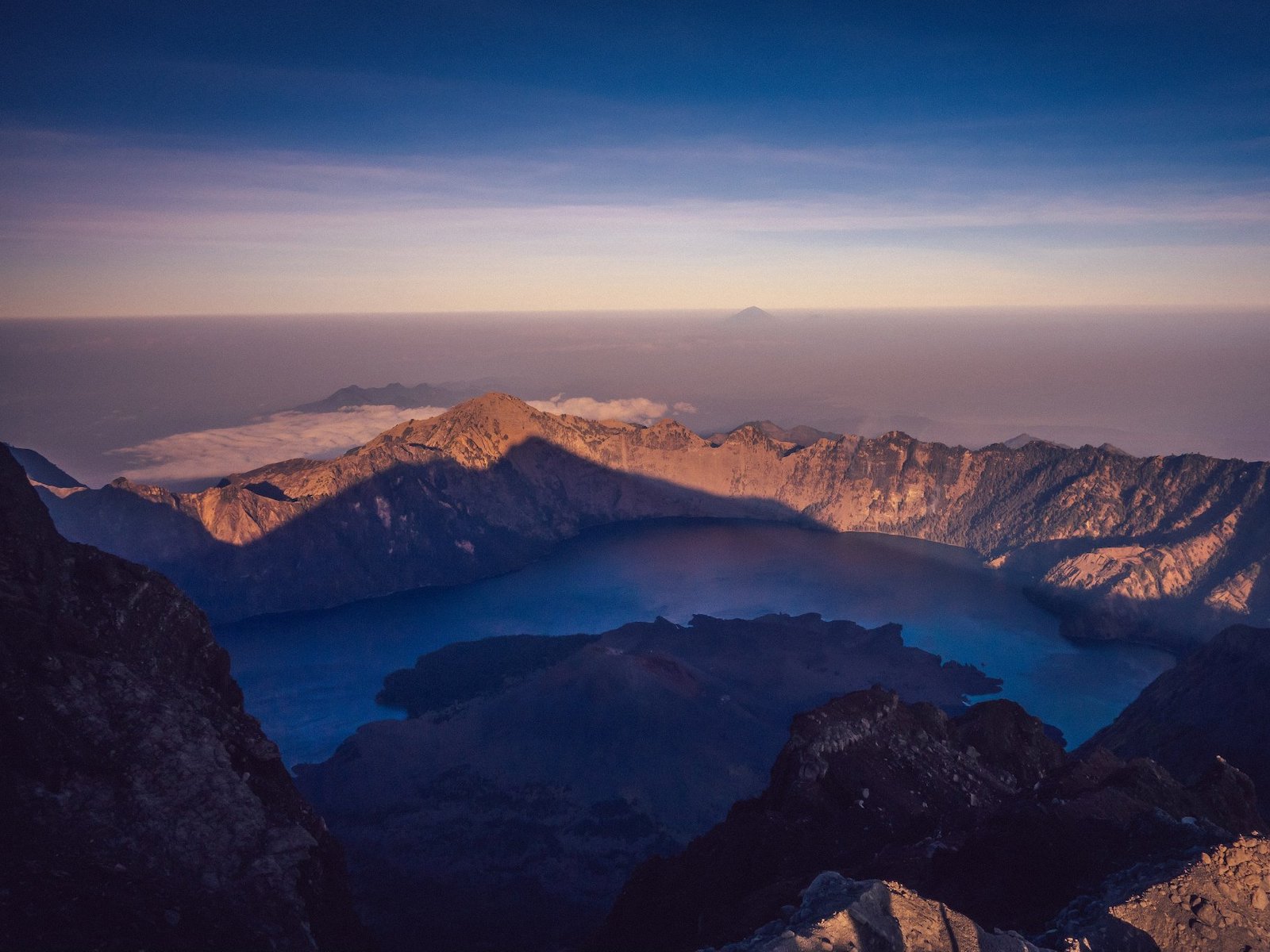
7) Mount Rinjani (Indonesia)
Location: Lombok, Indonesia
Length: 2 – 4 days return
Highest Altitude: 12,224 feet
Distance: ~ 21 miles
Difficulty: Moderate to Hard
Possibly one of the toughest hikes I have ever done, not because of the trail itself but due to the condition I was in while doing the hike. Hiking while suffering from good poisoning is not an ideal situation, to say the least.
That said, it is one of the best hikes you can do in Southeast Asia and you will be rewarded with a view of a volcano on an island inside a mountain on another island. Yes, that is indeed what you will see from the 12,224-foot-high summit of Mt Rinjani. The view is definitely better at sunrise when the shadow of the Mt Rinjani will be slowly receding from the volcano.
You will spend four days climbing up the ridge of the volcano, sleep under the stars, wake up early for a push to the summit and then down to the lake before climbing up again to another ridge and down, ending your trip. There is nothing more painful and rewarding at the same time than to climb up a volcano on a forever falling volcanic ash and then get to see a volcano on an island in a volcano on an island.
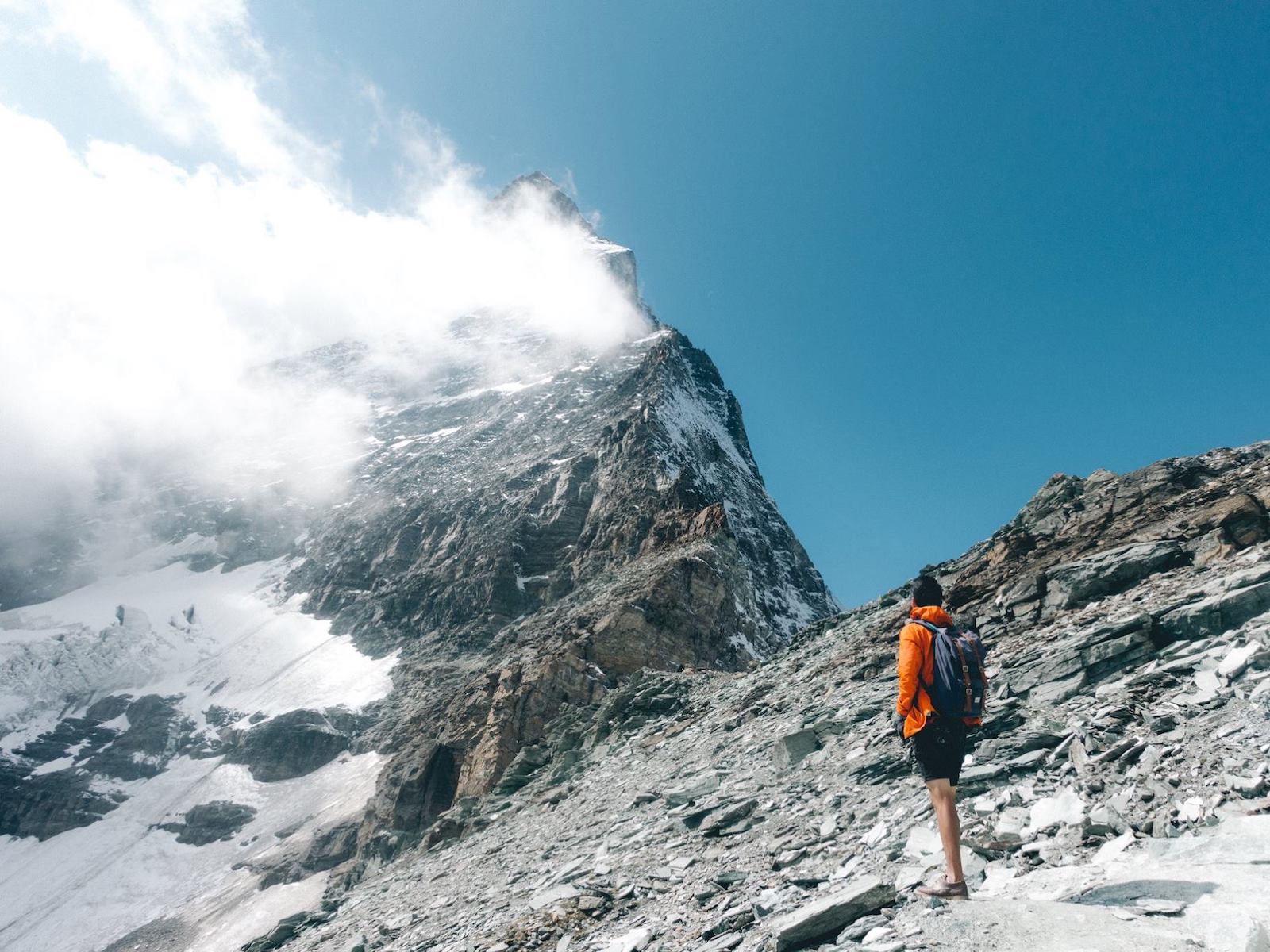
8) The Schwarzsee and Hornlihutte Trails (Switzerland)
Location: Zermatt, Switzerland
Length: 8 – 10 hrs return
Highest Altitude: 1,695 feet
Distance: ~15 miles
Difficulty: Moderate but Long
This is a combination of two trails that will get you the closest to the famous Matterhorn peak in Zermatt, Switzerland. The first part of the trail starts from the city of Zermatt and as you follow your way up the gondola line, you will arrive at Schwarzsee Lake where you can rest, have coffee at the mountain hut and continue your way up to the Hornlihutte. This is the exact location where one of the first climbers set off for their first ascent on the famous mountain in 1865.
You will go through a small traditional village before climbing up through the forest out into the exposed area at the Schwarzsee Lake. The landscape will become more rugged and rocky as you make your way up to the Hornlihutte mountain hut. If you decided to take an alternate route back via the Glacier trail, you will also be able to admire the mountain from the bottom of the glacier looking up. That was quite a sight to behold.
At the end of the Glacier trail, you will arrive at the Trockener Steg Lake where you can see the Matterhorn’s east face reflected off a body of water. There is no better way to see the Matterhorn than to hike this trail.

9) Laguna de los Tres trail (Argentina)
Location: El Chalten, Argentina
Length: 7 – 11 hrs return or 2 days
Highest Altitude: 3,871 feet
Distance: ~7.7 miles
Difficulty: Easy
Of course,Patagonia has to be on the list, but maybe this might not be the trail you are expecting. There are plenty of hiking opportunities in Chilean and Argentinian Patagonia, but the one I like the most is the Laguna de los Tres trail on the Argentinian side, starting from the quiet town of El Chalten.
This trail is my favorite because unlike the Torres del Paine and W Trek in Chile, the experience of hiking the trail is not ruined by the massive crowds that come with the peak season and has been plaguing those trails. Laguna de los Tres trail is a little less crowded, but offers you a similar experience as the trail will take you up close to the 3 famous landmarks of Patagonia, Mount Fitz Roy, Aguja Poincenot and Cerro Torre.
The trail is relatively easy compared to the other ones listed here with the majority of the trail pretty flat with two steep climbs at the beginning and at the end. You will pass through beautiful native woodland along the side of a mountain, coming across vast glaciers, frozen lakes and a few granite spires. As you continue on, you will pass through two camps where the last camp, Campamento Poincenot, is where you can stay overnight should you decide to extend the trip to two days. If you do so, I would recommend you go up to the Laguna de Los Tres as early as you can for the sunrise.
At the end of the trail, you will be rewarded with a stunning view of the impressive cobalt blue lake and icebergs of Laguna de Los Tres in the background. Over the icebergs, look up and stare at the looming spires of Fitzroy and its neighbors in awe and realize how fortunate you are to be able to see such beauty with your own eyes.

10) Laguna 69 (Peru)
Location: Huaraz, Peru
Length: 6 hrs return
Highest Altitude: 15,000 feet
Distance: ~7.4 miles
Difficulty: Moderate
Last but not the least, we are back in Huaraz again for another of my favorite trail, the Laguna 69 trail. This time, it only requires a day to complete but you will be rewarded with such a diverse scenery and plenty of photogenic mountains that you might forget you are doing a day hike. The trail begins slowly climbing through the valleys with several steep climbs along the way. Halfway through the trail, you will find a great spot by an alpine lake for a lunch stop before continuing on through a vast grassland. Push through the small granite path and head in to the heart of the mountain, where you will find a pristine blue glacier lake tucked away in between snowy mountains.
The moment you start to approach the lake, you will see a bright blue color, like nothing you have ever seen in nature. That’s when you will realize that you have finally reach Laguna 69. There is no mistaking it, the technicolor from the melted glacier is out of this world.
***
Nature has a way of rewarding you if you try hard enough and that is what I feel about hiking. The harder you work for it, the more rewarding it is. The mountain tests you, makes you lose your ego and you humbly appreciate both your own physical condition and the wild beauty of the world. I encourage you to go out there, get your hands dirty and start climbing.

/
 Pete Rojwongsuriya is the founder of BucketListly.Blog, a place where he writes about his travel adventure and life stories he learned for the last 6 years on the road. He is also a travel filmmaker, photographer and a digital nomad, traveling from one country to another, making inspiring travel videos, taking stunning photos and telling a travel story of the world. His work in travel films has been featured on National Geographic, BBC, and Vimeo.
Pete Rojwongsuriya is the founder of BucketListly.Blog, a place where he writes about his travel adventure and life stories he learned for the last 6 years on the road. He is also a travel filmmaker, photographer and a digital nomad, traveling from one country to another, making inspiring travel videos, taking stunning photos and telling a travel story of the world. His work in travel films has been featured on National Geographic, BBC, and Vimeo.
The post 10 Hiking Trails Around the World That Will Blow Your Mind appeared first on The Expeditioner Travel Site.
]]>The post Going “Deep” In Indonesia: Diving The Gilis appeared first on The Expeditioner Travel Site.
]]>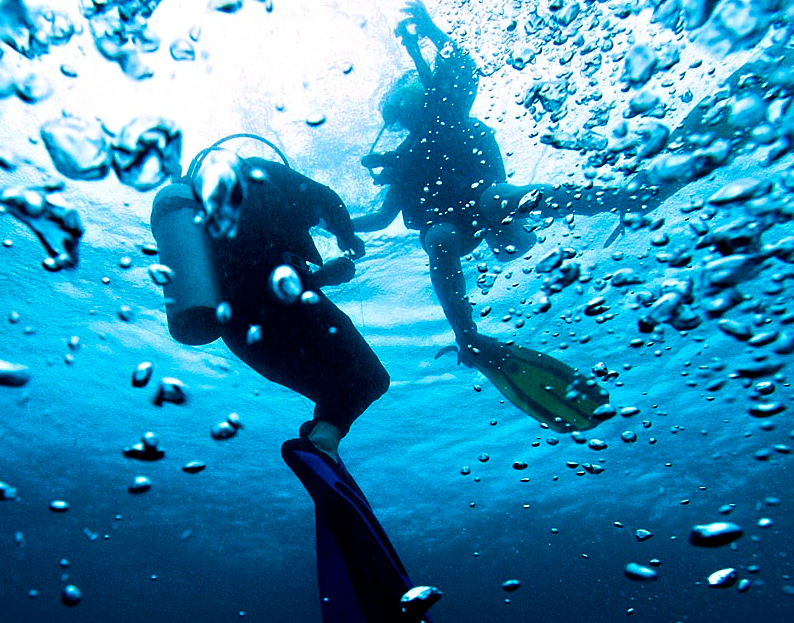
It is a glorious morning.
With the sort of light that deserves to have a few moments taken to stop, breathe it in, and absorb the possibility it brings; to make a memory of the way the sun dances across the sea, sprinkling it with gold; to relish the cool that blurs the horizon; to squint your eyes into the gentle mist which offers the promise of the hot day ahead.
But I am doing precisely none of these things, too distracted by the certainty that this will be the last dawn I see.
[Pause for dramatic effect]
Today I am scheduled for my first deep scuba dive: The dive that has prevented me from taking the PADI Advanced Open Water qualification since I first strapped on a BCD almost five years ago. And I’ve been awake all night, running possible scenarios through my head.
A lot can go wrong at 30 meters underwater, I’ve decided.
My head exploding like a pressurised grape or being eaten by the Loch Ness’s salty compatriot were perhaps a couple of the rather more far-fetched outcomes, sure. But at the very least, it must be pretty dark down there.
What if I get disoriented? What if I bolt for the surface? And I do not much like the sounds of this “getting narked” business. What if the anaesthetic effect of nitrogen narcosis (breathing in this compressed gas at depth) has me casually removing my life-conserving air supply far below the surface?
I had tried to console myself with the fact that it is not like I am being asked to descend in the murky waters of a highland lake. Instead, this scene plays out on Gili Air, the medium-sized of the three Gili islands, just off the coast of Lombok, and not far from Bali.
The tropical waters here are crystal clear, famous for their reefs, abundance of turtles and honeymooners (only the latter of which is to be keenly avoided). It is hard to imagine a more perfect spot to “go deep.”
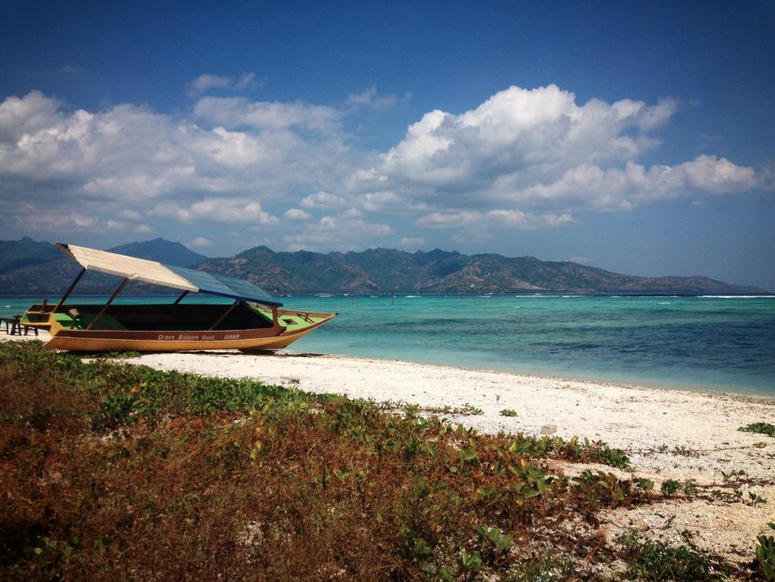
Yet reason continued to elude me as, palms sweating, the entrance to Oceans 5 comes into view. It is only pride that serves to overwhelm my compulsion to run in the other direction and have done with it.
I find my instructor amidst the traditional sun-bleached, torso-baring bustle of an early a.m. dive shop.
He goes by the name of Pierre, Belgian — “not French!” — and during the previous day’s exercises, including buoyancy control and navigation, I had decided that Monsieur P. and I weren’t likely to be life-long friends.
Pierre was strict. And thus, rather scary, wagging his finger at me as I bobbed helplessly past the metal rod I was apparently, somehow, supposed to be touching with my nose in an orderly fashion.
He also failed to comply with my imagination of the dive instructor aesthetic, conspicuously lacking in the shaggy hair department, and rather low on “happy-go-lucky.”
As we motored towards the dive site, however, traits I had resented in my mentor the day before suddenly became reassuring. He was clearly the unspoken leader of the whole operation, reprimanding those on the boat who failed to adhere to rules and regulations, with uncanny ability to see in several directions at once.
I was, I decided, in good hands.
So, masks on, regulators in, backward roll, splash: in we went and down we went. Myself, Pierre and a Danish character who had a great deal of enthusiasm but unfortunate propensity for clumsy lashings-out of the flipper.
10 meters . . . 12 meters . . . I glanced at the depth gauge on my computer every few seconds as we kicked gradually further into the blue.
15 meters.
18.
This is now the deepest I had ever been (officially) and Pierre checks back to see I am still up for going further. I am.
We drop further still.
25 meters.
28 meters.
And then I do the thing I promised myself I would not do, the equivalent of looking down when scaling a cliff: I look up, tilting my head to peer through the thermocline to the world above.
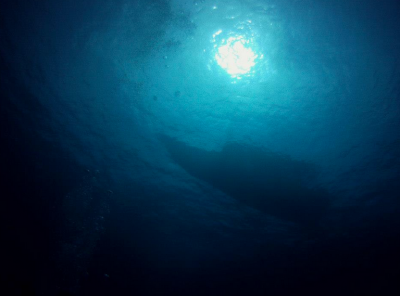
The panic I had been expecting does not come. I could not have felt more relaxed, elated by serenity and calm.
Reaching maximum depth, a huge barracuda emerges from the dark azure of wider ocean.
Pierre turns and gives me a huge grin and an “ok?” sign.
“Ok,” I nod, grinning — I imagine — somewhat maniacally.
I feel a rush of gratitude towards my underwater cohort.
What I had not realized before but realized then was that this guy was a pro. What I had construed as strict, was actually better understood as calm and considered professionalism, without which I likely would have bottled out before you could say “Moby Dick.”
All too soon, he is signalling to us it is time to come up. One of the downsides of going deeper of course being the reduced bottom time.
Right arm extended, my hand is the first to break back through the looking glass, the surface of the water a mirror below which an alternative universe conceals itself; a place where red doesn’t exist and doing the moonwalk is a legitimate possibility.
Back onboard I bask in the heat of that misty early morning promise made good, revelling in my albeit predictable survival.
Now my fear of going deep has only been replaced by a desire to go deeper. Trust me, once you go deep, you never . . . um . . . go shallow? Wait, no, that doesn’t work.
Either way, go find yourself a Pierre and get down there, “down where it’s wetter, down there it’s better, take it from me” [me and Sebastian the crab].

And as for the Gili Air as a location to base yourself? With reasonably priced accommodation in places like the newly opened Begadang Backpackers, as well as easy access to dive sites around Gili Trawangan and Gili Meno, you couldn’t ask for much more from a desert island.
/
 A restless Brit with big dreams and limited cash flow, Hannah is a freelance journalist and student. She is currently being sponsored by the European Union to take a Masters in Journalism and International Politics at the University of Amsterdam/University of Santiago, Chile, and the Danish School of Journalism. Check out her site DontDoNothing.com.
A restless Brit with big dreams and limited cash flow, Hannah is a freelance journalist and student. She is currently being sponsored by the European Union to take a Masters in Journalism and International Politics at the University of Amsterdam/University of Santiago, Chile, and the Danish School of Journalism. Check out her site DontDoNothing.com.
The post Going “Deep” In Indonesia: Diving The Gilis appeared first on The Expeditioner Travel Site.
]]>The post Facing The Feces Factor: Tasting My First Cup Of Kopi Luwak Coffee appeared first on The Expeditioner Travel Site.
]]>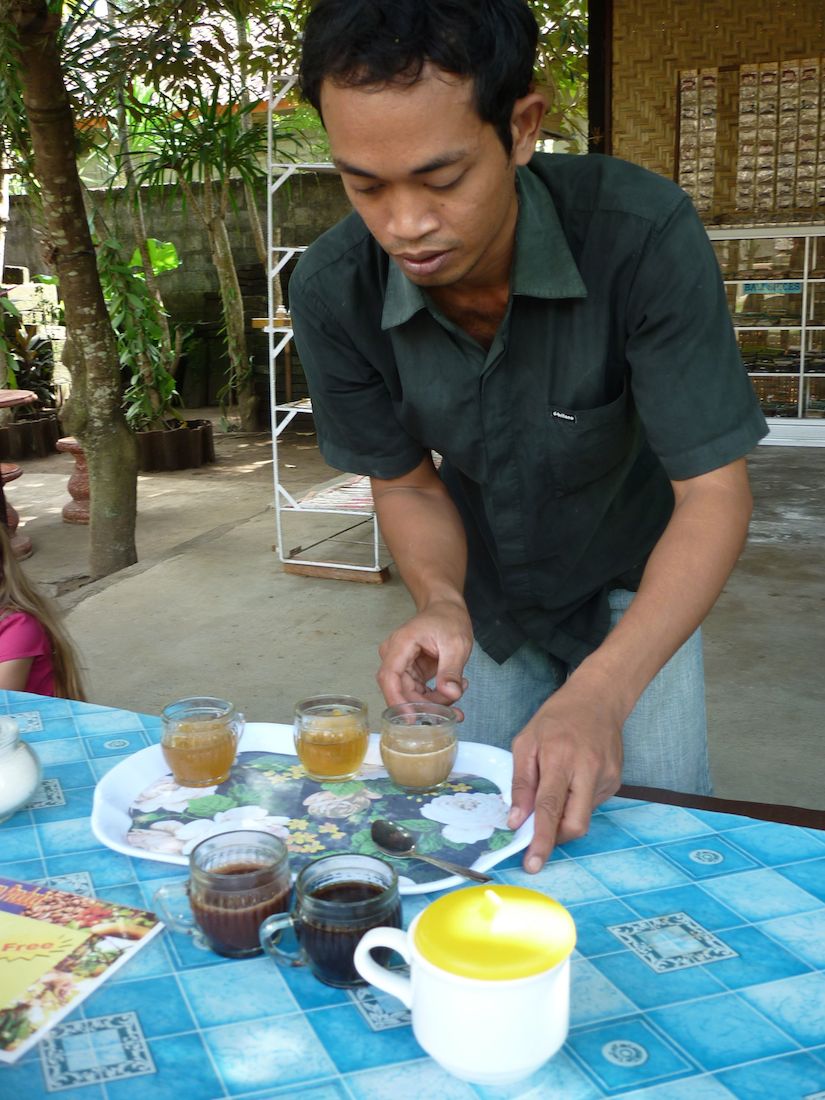
My first cup of Kopi Luwak coffee, sometimes better known as “cat poo coffee” or the rarest beverage in the world, was a memorable introduction into the highly envious world of extreme luxury, though this tasting occurred far outside the confines of the dining room of a fine-dining restaurant in Hong Kong or New York where cups of Kopi Luwak can run upwards of $50 (or $600 if you wanted to purchase a pound of these coveted beans).
In my case I was sitting at a picnic table covered with a blue-checkered tablecloth near the outskirts of the Indonesian jungle with my husband, Kurt, who had also noticed a hyperactive mongoose pacing in a cage nearby. It seemed rather random, but we were in Southeast Asia where we didn’t understand the local pet protocol.
We were far more focused on sipping the many varieties of teas and coffees offered by one of the hosts of a family-owned coffee compound outside of Ubud, Bali. After having toured the grounds along with our kids, we had been invited to the tasting.
However, we soon learned that the mongoose was actually a closely related animal called a civet, and it was not just an anxious pet ready for a romp in the rainforest. At this particular compound, the family produced a highly prized coffee, Kopi Luwak, which is processed in the stomach of the civet. The coffee farmers feed the beans or “coffee cherries” to the civet, and then the enzymes and acids in the animal’s stomach essentially marinate and break down the bean, thereby eliminating bitterness and creating the most expensive coffee beans in the world.
The catch: the only way to get the processed beans is by waiting for the civet to release them into the wild. Yes, until they defecate. Once this has happened, someone gets to pick the beans from the dung and remove the outer layer of the bean, so it is finally ready to be roasted. Our host explained this to us and gave us a flyer to read.
Frankly, it sounded like something that Eddie made up. Like any five-year-old, most of his revelations and stories involved poop, farts, boogers or any other product that shot or drained out of an orifice. Kurt and I looked at each other, considering the reality of this coffee. Our host offered each of us a cup.
“How about some Fecal Folgers?,” “A tall cup of nonfat, no foam turds, please,” “Well, I prefer a grande carmel macchiato from Starbutts.” It was too easy to make jokes, but should we drink it? Our dilemma was whether to be culturally sensitive and embrace the offering or to come off as lame, mistrustful tourists.
Kurt shrugged his shoulders and then both of us picked up the cups. If ever there was a one-of-a-kind cultural experience, this was it. I swished the coffee around in the cup. It looked like regular coffee — no suspicious residue readily visible.
Time to down the dung. It was really quite smooth, almost creamy. Actually, it was delicious. The host smiled and nodded as if he knew what we were thinking. He then gave cups to the kids. I almost put my hand out to halt him, but then I stopped. Normally, I wouldn’t let the kids, who were five and three years old, drink anything with caffeine, but what the hell? Why not?
Kurt and I drank the stuff. Plus, we hadn’t brought the kids to Bali to drink rainbow sparkle smoothies with Mickey and Minnie. At worst, we’d have a night of family bonding and barfing.
Both Eddie and Kasey grinned at each other after they drank the beverage. Part of the thrill, I’m sure, was that they were consuming something they knew was for adults. We also avoided telling them about the feces factor. However, we did inform them that they were drinking a “special” coffee.
Special indeed. In fact, coffee connoisseurs from around the world want these expensive coffee beans, which can cost hundreds of dollars per pound.
They also note that Kopi Luwak has seen a growth in popularity in recent years decades after almost disappearing as a beverage in Indonesia. Although historically Kopi Luwak has experienced various trendy times, especially with foreigners living in Indonesia. Dutch colonists consumed the Kopi from the 1600’s to the end of their rule at the beginning of World War II. Then, during the war, while Japanese soldiers occupied Indonesia, they developed a taste for the turdy beans.
And who can blame them? At the moment, I really couldn’t think of anything I’d rather do than hang out at Balinese family-owned coffee compound in the jungle and drink poop coffee with my own family and a hyper civet.
By Steph Glaser

ABOUT THE AUTHOR
 A freelance writer, teacher and traveler, Steph Glaser studied in the Netherlands during college and then updated a chapter on the country for the now defunct budget travel guide series, The Berkeley Guides. Additionally, as an American exchange teacher in Australia, she became fluent in Aussie teenage slang courtesy of her high school students. Currently, Glaser lives with her family in Colorado where she teaches public speaking and writes about her travel blunders for her blog, TravelOops.com.
A freelance writer, teacher and traveler, Steph Glaser studied in the Netherlands during college and then updated a chapter on the country for the now defunct budget travel guide series, The Berkeley Guides. Additionally, as an American exchange teacher in Australia, she became fluent in Aussie teenage slang courtesy of her high school students. Currently, Glaser lives with her family in Colorado where she teaches public speaking and writes about her travel blunders for her blog, TravelOops.com.
The post Facing The Feces Factor: Tasting My First Cup Of Kopi Luwak Coffee appeared first on The Expeditioner Travel Site.
]]>The post The Spice Of Balinese Life: Notes From A Cooking Class In Ubud, Bali appeared first on The Expeditioner Travel Site.
]]>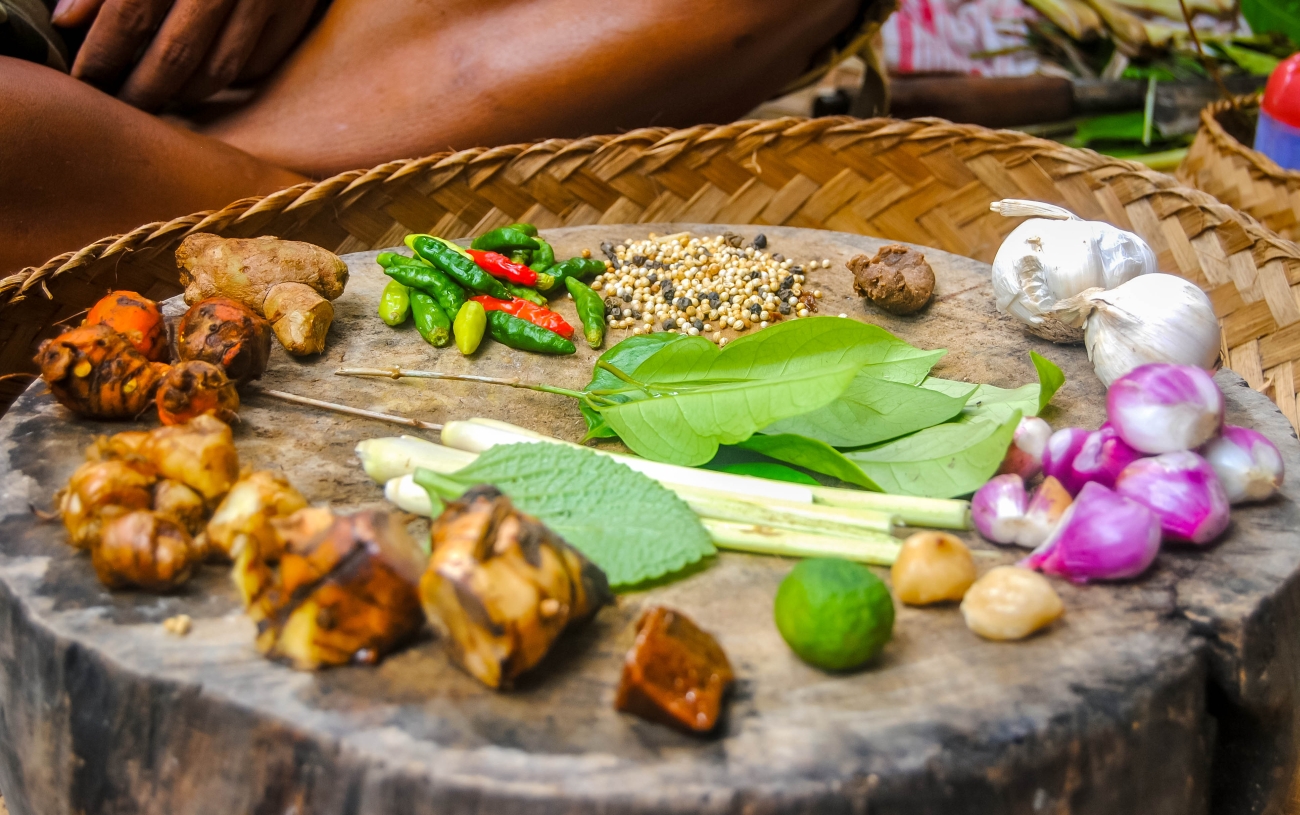
I am seated upon a bamboo mat on the ground, notebook in hand and appetite in tow. We have just returned to our lovely host home after an early-morning market excursion to purchase the necessities for our cooking lesson. Bundles of fresh tuna, ever-so-hideous jackfruit and ruby red tomatoes are just a few of the recognizable purchases. Lucky for us, the majority of ingredients we will be using can be found fresh in the garden where we are staying, only footsteps away from my comfy cross-legged seat.
I wait quasi-patiently while the slab of wood (for cutting) is cleaned and the knives freshly sharpened. I try to ignore the swarm of ants that are also attending our outdoor cooking class, keeping in mind that the food is always washed a final time before ending up on the stove. I remind myself how lucky I am to be in the middle of rice terraces and jungle, attending a private cooking lesson from a local Balinese family. Finally, after a couple of stomach grumbles have already begun, it’s time to get cooking.
The lovely couple, Made and Rinin, are our top chefs for the afternoon, and I couldn’t have asked for a warmer, happier pair to instruct me in the ways of Balinese food. Our menu for the day will include lots of soups — chicken soup, jackfruit soup, and cucumber soup. Fried tuna, tempeh (soybean cake) and sardines steamed in banana leaves will also make an appearance for the main meal. Desert will be sticky rice, dowsed in brown sugar and generously sprinkled with grated coconut. But before we can begin any of the cooking, we have to prepare the one essential ingredient, Bali’s special spice: base gede.
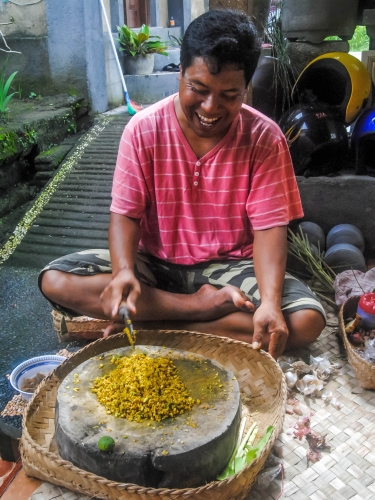
This colorful and aromatic spice is the base for all of Made and Rinin’s recipes. A beautiful assortment of ginger, garlic, shallots, coriander, red and green chilies, lemongrass, brown sugar and galangal are assembled upon our cutting board. Made pauses before adding the final ingredient, turmeric, to make certain he can explain its value as an antiseptic and energizer. He also ensures turmeric will save me from any stray bugs that make their way into our open-air kitchen. Although I try, I don’t think my smile in mock agreement to this last statement is very convincing.
The ingredients for the spice are now ready to be finely chopped. And then chopped again. And again. Finally, my cutting job is approved and we can move the mosaic of spices to a mortar and pestle. I’m allowed to grind at it for a while, until it becomes apparent we will never be allowed to eat if I don’t hand the tool over to my instructors. In mere seconds Made has created a fine paste, and the central spice is finished and allocated to the different dishes we’ll be preparing.
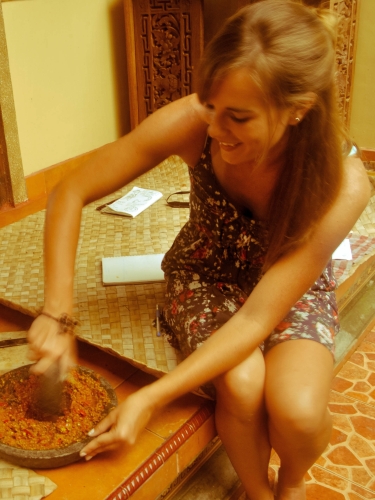
We chop the head off a chicken (thankfully already dead) and drop it into a pot of boiling water with lemongrass and the base gede. Somehow, the massive jackfruit is chopped open and the edible, raw fruits removed so they can follow a similar route. Finally, bites of cucumber and tomatoes, with a handful of coconut, are boiled to create our cucumber soup.
While the soups are simmering, the tuna and tempeh are fried in homemade coconut oil until golden brown. We cover every possible millimeter of the sardines with our special spice before rolling them in banana leaves and sealing them with wooden skewers. I’m not particularly good at getting the skewer in without severing the entire banana leaf, but my kind instructors just laugh it off. The sardines are sent to steam in bamboo baskets adjacent to the rice over a traditional fire out back. I can’t believe that our hosts prefer to use a wood fire to the stove, but Rinin insists that she can tell a difference even if it does take much longer to prepare. Unfortunately I don’t think the caliber of my taste buds is quite up to her standard.
And then finally, after the aromas have teased us for what seems like ages, the boiling and steaming and frying are finished. We can eat.
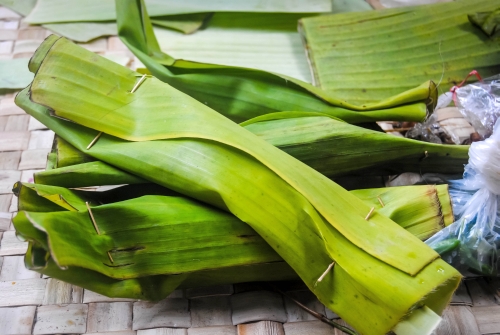
Often Balinese will go off on their own during meals so they can thoroughly enjoy the textures and flavors, but our personal chefs have insisted on joining my friends and I for our meal. We sit upon comfy cushions, still on the floor, having relocated to an outdoor dining area. Thankfully, the labor is well worth the reward. Rice is employed to soak up our numerous soups before we shovel the deliciousness into our mouths.
Made contends that Balinese food tastes better when eaten with your hands, and I think I might actually agree as I forego the use of utensils. Despite the fact that the base gede went into everything we cooked, all the dishes taste unique, balancing spicy, salty and nutty flavors. I can’t get enough of the simple tempeh, although the sardines are a close second. And just when I am about to burst, I remember the sticky rice is still coming my way, a special addition to our meal from Rinin’s heart. It’s incredible, and the subtle sweetness is a welcome endnote to the spiciness of the meal.
I haven’t yet tried to recreate any of the dishes I learned to cook from the class. I’m not sure I’m even going to try, to be honest. What Made and Rinin offered me that day was enough for a lifetime. Through the noises and bartering at the morning market; the colorful array of exotic spices arranged on our wooden slab; the way they made me feel like family, joking at my slow cooking skills compared to their efficient and knowledgeable hands, Made and Rinin gave me a brief glimpse into true Balinese culture. They brought me straight into the day-to-day lives of traditional Ubudians, and for this, I will be forever grateful.

If you’re interested in scheduling your own private cooking class while in Ubud, click here to contact Made and Rinin at the Dukah Village.
About the Author
 Casey Siemasko is an avid traveler, finding her inspiration when exploring new places and meeting new people. When she’s not teaching English or blogging, she enjoys practicing yoga, training for marathons and scuba diving. Oh, and wine. She and her husband comprise the two lovebirds documenting their travel musings at ACruisingCouple.com. Currently residing in Taiwan, they are gearing up for life on the road, starting in Southeast Asia this fall.
Casey Siemasko is an avid traveler, finding her inspiration when exploring new places and meeting new people. When she’s not teaching English or blogging, she enjoys practicing yoga, training for marathons and scuba diving. Oh, and wine. She and her husband comprise the two lovebirds documenting their travel musings at ACruisingCouple.com. Currently residing in Taiwan, they are gearing up for life on the road, starting in Southeast Asia this fall.
The post The Spice Of Balinese Life: Notes From A Cooking Class In Ubud, Bali appeared first on The Expeditioner Travel Site.
]]>The post Is It Possible To Actually Enjoy Bali? (Here’s How) appeared first on The Expeditioner Travel Site.
]]>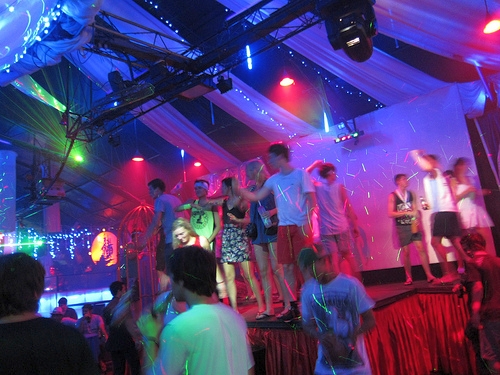
Full disclosure: I’ve never been to Bali. It’s not that I haven’t been in the general vicinity, or have had the chance to go there over other destinations that are roughly the same distance from New York, but I’ve got to admit, it’s quickly become one of the few places in the world where my self-pronounced (though often vocally suppressed) travel snobbery has kicked in and made me want to avoid like the plague.
How can it not, what with a cursory Google search of the search phrase, “Bali sucks,” resulting in three articles from travel bloggers I respect essentially telling the world: don’t go there? For a few examples: LeaverYourDailyHell.com (“Is Bali Worth It?”), AdventerousKate.com (“Kuta: The Worst Place In Bali”), or WanderingEarl.com (“When Tourism Goes Terribly Wrong”).
But to be fair, one common thread throughout all of these articles — other than the ever-presence of drunk Australians, blatant commercialization and a general desire to take a shower after visiting — was the fact that Bali itself should not be judged by Kuta (the main city in Bali where most travelers begin their trip). Reasonable enough, as it would be equally unfair to judge the entire Yucatan by Cancun, or Jamaica by Negril. The fact is, like anywhere you visit, it helps to know where to go, and perhaps even more importantly, to get as far away as possible from where all the tourists are.
Lonely Planet recently wrote about some suggestions of places to experience around Bali that won’t make you want to hop back on the plane minutes after you disembark. For example, Lovina, in the northern part of the island, is a great place where you can enjoy the black sand beaches and seafood warungs away from the crowded masses. Or you can head to the highlands of the island and visit Gunung Batur, Bali’s second highest volcano and home to two small villages, Kedisan and Toya Bungkah (look, no body shots happening here!).
And if you’ve really had enough of the island but need to stick around the vicinity due to time restrictions, hop a boat and visit the nearby Gili Islands, where cars are not allowed and numerous dive operators offer excursions to the many reefs and diving spots around the three islands.
So, yes, there are probably plenty of reasons to avoid Bali if you’re one of those travelers that tends to avoid tourist traps, but you do have options, just be prepared before you go.
By Matt Stabile

About the Author
 Matt Stabile is the Founder and Editor-in-Chief of The Expeditioner. The Expeditioner began in 2008 and is headquartered in New York City. You can read his writings, watch his travel videos or contact him at any time at TheExpeditioner.com. (@TheExpeditioner)
Matt Stabile is the Founder and Editor-in-Chief of The Expeditioner. The Expeditioner began in 2008 and is headquartered in New York City. You can read his writings, watch his travel videos or contact him at any time at TheExpeditioner.com. (@TheExpeditioner)
The post Is It Possible To Actually Enjoy Bali? (Here’s How) appeared first on The Expeditioner Travel Site.
]]>The post Bali: The Island You Thought You Knew [Travel Video] appeared first on The Expeditioner Travel Site.
]]>Forget the yoga retreats, luxury spas, poolside Jamu massages, and the recently-divorced-women-of-a-certain-age that have all unfortunately come to symbolize the Bali of today. Instead, think (and watch) lush jungles, religious ceremonies and majestic vistas that make this island truly The Island of the Gods.
[The Island of the Gods (Bali)/Vimeo]
The post Bali: The Island You Thought You Knew [Travel Video] appeared first on The Expeditioner Travel Site.
]]>The post Girls Gone Wild In Bali appeared first on The Expeditioner Travel Site.
]]>
For those of us from North America, spring break is known as the week when pasty Greeks and their college brethren from all over the country descend onto the warmer locales of Panama City, Cancun and Negril for a booze-fueled orgy of bucket beers, foam parties, regrettable tattoos and other activities that one can only hope penicillin is the answer to.
In Australia, the equivalent is schoolie’s week (or leaver’s week), where newly graduated high schoolers head to the Gold Coast or parts of Southeast Asia at the end of their school term in late November and early December to, well, basically do the same thing.
The SMH recently headed to Bali to check out the growing popularity of schoolies traveling to Kuta in southern Bali, where the city was gearing up for about 6,000 revelers to descend on the former fishing village (and more recently, site of both the infamous 2002 and 2005 club bombings).
Beware, they discovered that among the schoolies there are toolies, their slightly older kin.
In their wake come the toolies. They’ve had a few more years than the male school leavers to sculpt their pectorals and submit to the tattooist’s needle, and they fancy their chances in the competition for girls . . . “We come, tattoos and that, and looking a bit older. That’s what the girls are after.”
But why Bali when they have one of the world’s most scenic coastline (the Gold Coast) in their own continent to visit? The answer is simple: Cheap prices and a proliferation of unregulated activities including magic mushrooms, underage drinking, hepatitis-laced tattoo needles, the lack of motorbike helmet laws, roaming gangs of steroid-popping 20-somethings and of course snorkeling. What more could a 17-year-old want in life?
During the day they’ll go snorkeling bungy jumping, or to the Safari and Marine Park. But at night, “you can be hammered on the street and walk around.” . . . A number of schoolies say they intend to get a tattoo on their last day in Bali — Callum’s will adorn his chest and say “Brother Like No Other” — but some parlors are linked to hepatitis infections, even HIV.
I have to say, I’m quite disappointed by all of this. While these Australian youths are out cavorting at the end of their school year, I can assure you that their American counterparts are doing just the opposite. I myself found time during my spring break week to both adopt and raise an endangered orphan Northern Sea Otter (Enhydra lutris kenyoni) and begin my long-anticipated mapping of the human genome. I only hope that these Aussie youths will soon find their way.
[School’s out, Bali’s in, toolies eye the pool]
[Kuta Club by Aiko Konishi/Flickr]
The post Girls Gone Wild In Bali appeared first on The Expeditioner Travel Site.
]]>The post 7 Tips For Travel In Southeast Asia appeared first on The Expeditioner Travel Site.
]]>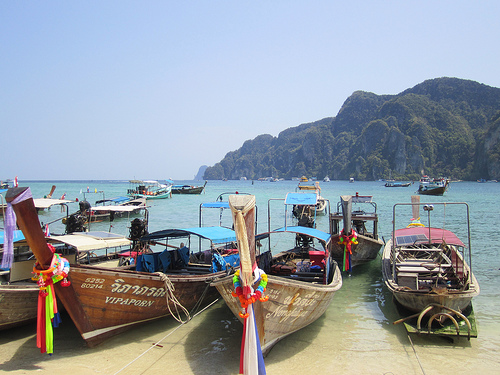
Southeast Asia is probably the best place in the world for your first extended backpacking trip. The food is delicious, the locals friendly, the beaches extraordinary, the accommodations well-established and the sites varied and unforgettable. You’re likely to return home with plenty of fond memories and incredible photos of Southeast Asia. If you’re considering setting off for Thailand, Malaysia, Laos, Cambodia, Vietnam, or any other country in the region, keep these tips in mind.
1) Stay Longer in Fewer Places
One of the biggest mistakes I saw was travelers rushing through an itinerary with too many places in too little time. No matter how long your trip is, it’s advantageous to go fewer places, while spending more time in each place. I would also encourage you to take more time than you think you need or want. Chances are you’ll wish you had more time.
On my recent trip to Southeast Asia, I saw one young backpacker who had begun to resent the region. He had been pushing too quickly to “see” whatever it was that he thought he had to see, ran into some unexpected difficulties and got extremely frustrated. Take it more slowly and you’ll have a better trip.
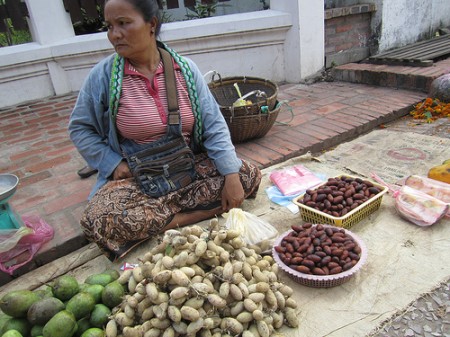 2) Don’t Plan Too Much
2) Don’t Plan Too Much
Leave room for spontaneity. That’s part of what makes traveling fun. You might want to plan a basic outline of the major places you want to visit. But give yourself plenty of time to absorb the atmosphere of the cities and villages and leave time in case you meet people and decide to do an impulsive side trip.
There’s no need to make reservations anywhere in Southeast Asia. You can just show up and shop around for your accommodation. I traveled for three months and never made one. I had a roof (and an inexpensive one I’ll add) over my head each night.
3) Travel With a Different Guidebook
Everybody has a Lonely Planet guidebook. Don’t buy one. Get a Rough Guide, Moon or Footprint. Lonely Planet channels everyone into the same guesthouses and hostels and that drives prices up. Plus, these guesthouses fill up more quickly. A good tactic is to check out a few guesthouses located around the ones listed in your guidebook. They are usually of the same standard and sometimes cheaper. I also always look at more than one place . Bargain friendly, and take the one that suits you best.
I generally choose my guidebook by the one that has been updated most recently. And remember, if at times of weakness, you are missing your LP, chances are the backpacker on the bus in the seat next to you has one.
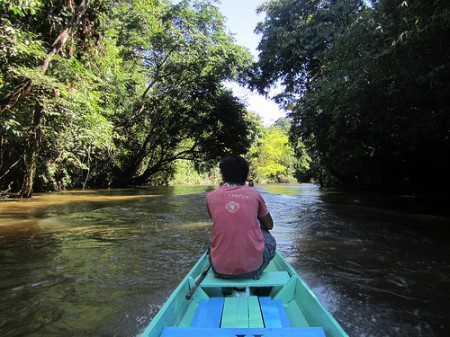 4) Avoid Multi-Day Packages and Backpacker-Only Buses
4) Avoid Multi-Day Packages and Backpacker-Only Buses
These are designed to make traveling easier. Organizers facilitate border crossings, transportation connections, accommodation and sometimes visas. In my opinion, this takes the fun and challenge out of independent travel. Figuring out transportation logistics is half the battle of traveling. Our detailed guidebooks make it easy enough, anyway. The multi-day packages also keep backpackers together and discourage interaction locals.
Another reason to avoid these packages, as well as international buses and VIP buses, is that you become an easier target for scams. In general Thais are pretty honest people, except when it comes to the individuals running the foreigner-only long distance buses from Khaosan Road to the rest of Thailand. I’ve heard some nasty stories of long delays, stranded travelers and multiple accounts of theft. Best to keep to the normal buses that leave from the bus stations.
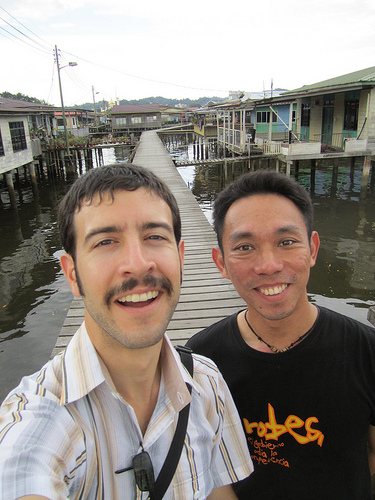 5) Travel With a friend; Travel Alone
5) Travel With a friend; Travel Alone
If you are traveling alone, great, you will meet plenty of people, both local and fellow travelers. If you are traveling with a friend, you will get lots of quality time with that person. Try to structure time away from your travel companion for a couple of reasons.
First, it will give you the independence to experience traveling on your own: meeting new people, making your own mistakes and choosing your own adventures. Secondly, it will improve and strengthen your relationship with your friend/partner when you return to each other. I used this scenario during two different trips with a good friend and it worked well. I also noticed that I have different and richer travel experiences when I’m alone.
6) Pack Light
This is one of my universal travel truth tips. It is always a good idea to pack as light as possible. Remember, you’re carrying everything on your back. Carrying less will obviously be lighter and increase your mobility, but it will also make getting in and out of transport, and to and from your accommodation easier. There’s really no need to take more than three or four changes of clothes.
If you’ll be working from the road or are a serious photographer, you might have a decent amount of equipment (extra lenses, external storage devices and laptops). But, most of us can just hit the road with a medium-sized backpack and small personal bag for valuables. I generally put nothing of value in my backpack. Although crime and theft in Southeast Asia is very unusual, I still want peace of mind when I throw my bag under or on top of the bus. And if your backpack is small enough, you may be able to carry it on with you, including during your flight, which could also save you money.
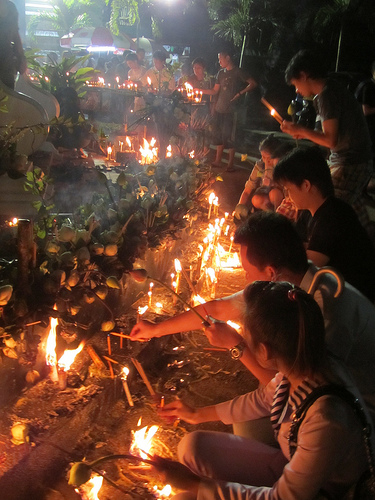 7) Avoid Burnout
7) Avoid Burnout
If you’re going to be traveling for more than two months, you’re going to need to recharge your batteries. Everybody does this in his or her own way. It could be alone with a book, a film, spending a day inside a nicer hotel room, eating comfort food, playing football — whatever.
Know yourself and know what you need to get a fresh perspective of where you are and what you’re doing. I’ve seen travelers get really frustrated and begin to develop animosity towards the country that they’re in at the time.
Author Paul Theroux, in his latest book, suggests bringing reading material unrelated to the country in which you’re traveling. At the end of a culturally intense day in Cambodia, you probably don’t want to wind down by reading a book that takes place in Southeast Asia. Rather, take one that will provide some relief through means of escape.
[All images via the author]

About the Author
 Stephen Bugno has been traveling the world for more than a decade as both a volunteer and a wanderer, and is the editor and publisher of the online travel magazine GoMadNomad.com and his personal site BohemainTraveler.com. You can follow Stephen via twitter at @bohemiantrav or on Facebook.
Stephen Bugno has been traveling the world for more than a decade as both a volunteer and a wanderer, and is the editor and publisher of the online travel magazine GoMadNomad.com and his personal site BohemainTraveler.com. You can follow Stephen via twitter at @bohemiantrav or on Facebook.
The post 7 Tips For Travel In Southeast Asia appeared first on The Expeditioner Travel Site.
]]>The post How To Find The Real Bali By Bike appeared first on The Expeditioner Travel Site.
]]>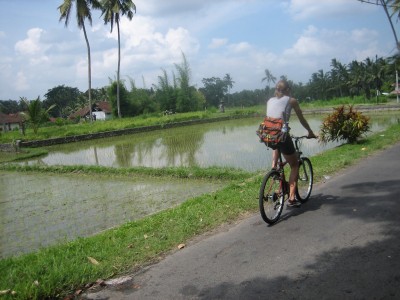
There is a saying: “To really see a country, leave the city.” Just as Paris may not be the best representation of France, and New York City isn’t a complete portrayal of the United States (sorry Matt), the same can be said about other parts of the world, Bali for example.
There are two well-traveled versions of Bali, both of which are arguably not the “real” thing. Who doesn’t enjoy sprawling out on the endless beaches the island’s known for, or exploring the markets and eateries of the densely populated triangle between Kuta Beach, the capitol city of Denpassar, and the hill town of Ubud. They are alluring areas, but many don’t venture beyond them. For a real taste of the island, try ducking into one of those tourist offices in Ubud’s main road and you can arrange a guided bike ride through the less-visited countryside.
The NZ Herald recently described this excursion away from the sand and crowds. Bikes and travelers are taken by bus, uphill, stopping at a volcanic crater that dominates the landscape, then onto breakfast where they’re likely to encounter a “cat fox,” the nocturnal animal that is the source of the world’s most expensive coffee. In the wild, the cat fox (or luwak to be technical) selects the reddest, ripest coffee beans and eats them, discarding the beans “out the other end” where the nuggets are dried and the beans are harvested. (The coffee sells in Bali for around $700/kg).
After breakfast, travelers then hop on bicycles and zip past the tiny shops that make up Bali’s smaller villages. The guide explains the importance of BBC to Bali’s economy — banana, bamboo and coconut — as they roll by farming terraces carved into the hills. Fields stretch onward, with whole families working to harvest soy, rice and tapioca.
Though Bali’s sand and resorts lure people there from all over the world, perhaps the true Bali — the Bali far from the visitors — is what many of are seeking. The author of the NZ Herald piece would likely agree:
We drift past exquisite rice fields flanked by dark, swaying coconut palms and pass the temples which shape and anchor Balinese life. There is beauty everywhere, natural and created. This is the Bali I have been searching for — contained, quiet, peaceful.
[Go by Bike by Axoplasm/Flickr]
By Jon Wick

About the Author
 Jon lives in Butte, Montana, spending most of his time on skis or bikes; sometimes both. He began travel writing while teaching in Korea and is currently pursuing his Master’s Degree in Technical Communication at Montana Tech. Jon has begun writing his first book, The Story of Will, whose movie rights are still (very) available. Catch more of Jon at TheJonWickproject.wordpress.com. (@ExpedJon)
Jon lives in Butte, Montana, spending most of his time on skis or bikes; sometimes both. He began travel writing while teaching in Korea and is currently pursuing his Master’s Degree in Technical Communication at Montana Tech. Jon has begun writing his first book, The Story of Will, whose movie rights are still (very) available. Catch more of Jon at TheJonWickproject.wordpress.com. (@ExpedJon)
The post How To Find The Real Bali By Bike appeared first on The Expeditioner Travel Site.
]]>The post “Eat, Pray, Leave”: Let The Backlash Begin appeared first on The Expeditioner Travel Site.
]]>
Seven million copies, 170 weeks and counting on the New York Times Best Seller List, and one Julia Roberts-starring movie later, Elizabeth Gilbert’s “Eat, Pray, Love,” may, surprisingly, just be entering the backlash phase that was inevitable from a book with such runaway success. We’ve seen this story before: Peter Mayles helped ensure a rate hike in summer rentals in the south of France with “A Year in Provence,” Frances Mayes did the same for Tuscany with “Under the Tuscan Sky,” and Alex Garland inspired hordes of backpackers to swarm Thailand with “The Beach” — incidentally, a book criticizing just that.
As Time notes, the biggest recipient of visitors due to the book seems to be Bali, where they note, from “January to March of 2006, 237,260 foreign tourists stopped by Bali. Since then the number has swelled steadily, and in the same three months of this year, there were 551,186 visitors to the island.” Visitors today can (for $3,000) sign up for “Eat, Pray, Love” package tours, which includes a session with Ketut Liye, the healer Gilbert herself visited while on the island, as well as stops to various locations mentioned in the book.
Of course, the locals are not happy, as Jezebel reports, and by unhappy locals we mean mostly English-speaking expats and “ponytailed men who once lived in Northern California” who now call Ubud, Bali home. They sell “Eat, Pay, Leave” T-shirts, and sneer at the mostly 40-something female travelers who’ve arrived looking for their own spiritual enlightenment and time to put in on their own soon-to-be bestsellers. And like a certain female-centric movie set in New York City did to many spots there, Jezebel “fears that once the movie opens, this whole area will turn into a far-flung Magnolia Bakery line, with women typing frantically on their blackberries and snapping photos of menus and street signs as their bored boyfriends gaze off into the middle distance.”
I can’t say this is much of a surprise. I mean, after all, isn’t this the classic lament of all travelers (see “The Beach” above). And not just travelers, you can apply this to all walks of life. Movies, books, bands, neighborhoods, food trends, web sites; name one popular example of any of these things, and you’ll find someone lamenting the fact that they were a fan before everyone else, and how it just isn’t the same.
Which is not to say that I can’t relate. Everyone has a certain amount of snobbery in them when it comes to something they love. It shows they care enough that they fear for the consequence of what popularity will bring. This is understandable, but is this really the fault of those who are causing the popularity? Is it the general population’s fault they love something, or somewhere, for the very reasons that the initial early adopters did? Should they be deprived of experiencing someplace just because they arrived five minutes after the rest of the world began to take notice?
I don’t know. I want to say yes. Too bad, you had your chance, go discover your own off-the-beaten-path paradise. Which is actually very good advice. In fact, with this site, I advocate just that, and I try to put it into practice when I travel myself. Would that cause me to not visit Ubud? No. Would I, myself, likely sneer at the “locals” and lament the influx of travelers. Yes. I’m just being honest. But the minute I began to feel that resentment creeping in, I’d high-tail it out of there with the speed I’d probably sneak out the back of the theater of a Julia Roberts flick. It’s not personal, I just have other islands to explore.
The post “Eat, Pray, Leave”: Let The Backlash Begin appeared first on The Expeditioner Travel Site.
]]>The post Video: Why Would Anyone Want To Leave Bali? appeared first on The Expeditioner Travel Site.
]]>The girls over at Something Creative decided to trek off of their home island of Bali, and head one island over to Gili Trawangan, off the coast of Lombok, Indonesia, where where the roads are carless, the shallow waters are ripe for diving, and the mood is laid back. Okay, this kind of describes much of Indonesia, but that’s not to say you shouldn’t explore a bit, right?
Remember to upload your own travel videos at TheExpeditioner’s Vimeo group here.
The post Video: Why Would Anyone Want To Leave Bali? appeared first on The Expeditioner Travel Site.
]]>The post Taming The Brutal Kimodo Dragon . . . Sort Of appeared first on The Expeditioner Travel Site.
]]>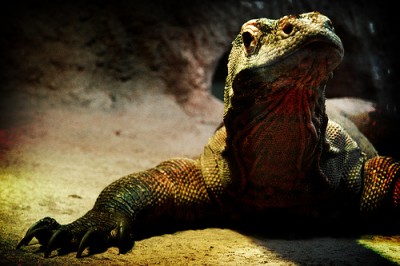
Real adventures, I mean the utterly real, still exist. You may have to look quite hard for them, but they’re still out there. The Telegraph recently recounted a trip into the lair of the fire-breathing, man-eating lizard, the Kimodo Dragon.
At first glance, I thought this was one of those real kind of adventures. Not so. There wasn’t any fire breathing, nor any human prey. There really wasn’t any real adventure outside of battling a gin and tonic hangover. Although, I have to admit, being face-to-face with the world’s largest lizard would sure make me feel like Captain Jack Sparrow taming newfound wilds.
Dragon territory, on the Indonesian islands of Rinca and Komodo, are a part of a ten day sailing itinerary the article describes, from Bali through Komodo National Park. Although the area is known as a hot spot for diving with sharks and manta rays, the hikes through a dragon-infested rainforest, for some weird reason, appeals to me. Just imagine . . . ten-foot-long, cannibalistic lizards live in trees, under porches, and in the sea. Yeah, the 4,000 of these living in the wild — Could. Be. Anywhere.
The epic encounter went like this: “For a minute the dragons seemed docile. But then something disturbed the group. In a flash they rose up on haunches encased in folds of scales and darted forward at speed, their thick bodies switching from side to side in a manner that was alarming in something 10 feet long. Deep inside, some innate urge screamed ‘Run.'”
And run they did. Our dragon slayer ran right back to the comforts of the air conditioning, sun loungers, and well mixed G-n-T’s of the tour guide’s sailboat. It looks like taming the menacing Komodo Dragon will have to wait until the next “adventure” (read: luxury sail trip through Indonesia).
The post Taming The Brutal Kimodo Dragon . . . Sort Of appeared first on The Expeditioner Travel Site.
]]>The post Borneo: See Unforgettable Wildlife, Almost Get Bitten By A Deadly Snake, All In One Day appeared first on The Expeditioner Travel Site.
]]>
It’s probably fair to say that Bako National Park, in Borneo, is the only national park in the world where you are likely to run into hairy-nosed otters, flying lemurs, silver-leaf monkeys, honey bears, and green pit vipers (whose poisonous bite will kill you within a matter of hours), all in a single day. And you wanted to take the kids to Disney World?
Located in the state of Sarawak, TSMH heads into the forests of Borneo to the national park (via boat — the only way to get there), to explore the truly remarkable cornucopia of wildlife that calls these forests home.
Sarawak is one of two Malaysian states on the island of Borneo (the other is Sabah). In an area about the size of England lies one of the most ecologically diverse regions on Earth. It’s a veritable living laboratory; a Noah’s Ark of unique plants and animals sustaining 27 diverse ethnic groups.
The sad part is, as the article points out, these lands have been heavily deforested, with estimates for the amount of forest that has been cut due to logging and to make way for palm oil plantations as high as 50%. Which makes you wonder, who’s the bigger danger, that venomous viper or that two-legged human?
The post Borneo: See Unforgettable Wildlife, Almost Get Bitten By A Deadly Snake, All In One Day appeared first on The Expeditioner Travel Site.
]]>The post Looking For Roasted Pig And Bras? You’ve Come To The Right Place appeared first on The Expeditioner Travel Site.
]]>Known for its many food stalls serving perhaps Bali’s most famous dish, Babi guling — a spiced roasted pig traditionally made with a whole suckling pig that’s been stuffed with a fragrant spice paste and spit-roasted over a barbecue — Gianyar’s night markets come alive after 6 p.m. Head there with Soma and Mila, two expats living in Bali, to try a banana and palm sugar dessert, shop for leftover bras, and get stuck in some massive traffic.
The post Looking For Roasted Pig And Bras? You’ve Come To The Right Place appeared first on The Expeditioner Travel Site.
]]>The post Eating At Your Friendly Neighborhood Balinese Warung appeared first on The Expeditioner Travel Site.
]]>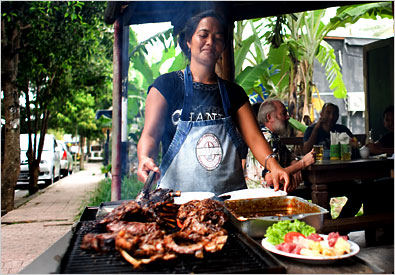
There are people who like to eat local and then there are people who like to eat local. It’s quite a difference. Eating street side vendors is often an experience, a lesson in culture, and a deliciously cheap meal all wrapped up into one juicy, roasted, suckling pig.
Ibo Oka is what the Balinese locals call a warung, the kind of vendors scattered all around the island, and Asia for that matter. The NY Times shares four of these prime spots, easily sitting me down in a wobbly plastic chair, with an absurdly good martini, under a weathered CocaCola umbrella. Besides Ibo Oka’s pig roasts, check out Merta Sari’s fish patay, Ayam Taliwang’s whole chicken rotiseries, and Naughty Nuri’s popular sushi Thursdays (and vodka martinis- just tell them Anthony Bourdain sent you).
Street side vendors are kind of an anomaly, really. Guidebooks and hotels scream warnings about places like this, but “if you heed their warnings, you’ll miss some of the best food the island has to offer, from melt-in-your-mouth roast pig and fish satays to just-caught sashimi and spicy fried rice served with chicken prepared three ways.”
Ah… I know where I’m eating.
The post Eating At Your Friendly Neighborhood Balinese Warung appeared first on The Expeditioner Travel Site.
]]>The post Top 10 To-Do List For 2009 — Way Better Than 2008’s appeared first on The Expeditioner Travel Site.
]]>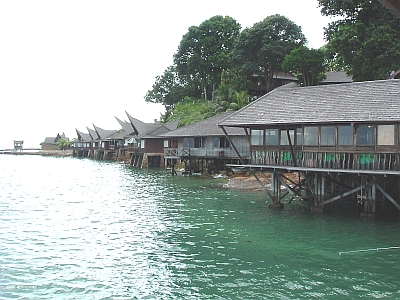
China’s having a six-minute solar eclipse in July, Berlin’s celebrating 20 years of reunification in November, French Guiana is still amazingly diverse, and Bintan Island is emerging as the place to be among the 3,200 islands in the Riau Archipelago — take that Rempang.
The other six to-do’s are kind of lame, and like most of your to-do lists that you’ve made over your lifetime, will likely be discarded and forgotten soon thereafter. But there’s always 2010.
The post Top 10 To-Do List For 2009 — Way Better Than 2008’s appeared first on The Expeditioner Travel Site.
]]>The post Exploring The Wonders Of Central Java appeared first on The Expeditioner Travel Site.
]]>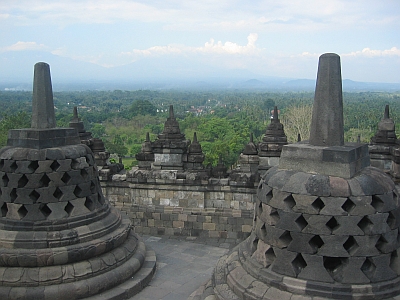
Take a step back in time by about 1,000 years at Borobudur and Prambanan, some of the most spectacular sites in all of Indonesia. Borobudur, a vast monument containing 72 Buddha statues, and Prambanan, one of Indonesia’s largest temples, are both UNESCO World Heritage Sites, and oftentimes some of the region’s most popular attractions, but for good reason. Hey, it’s the world’s most crowded island, be glad you found somewhere to sleep the night before.
The post Exploring The Wonders Of Central Java appeared first on The Expeditioner Travel Site.
]]>